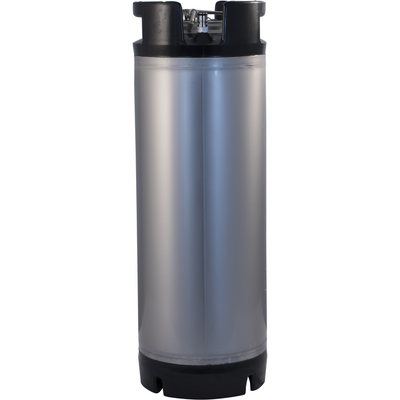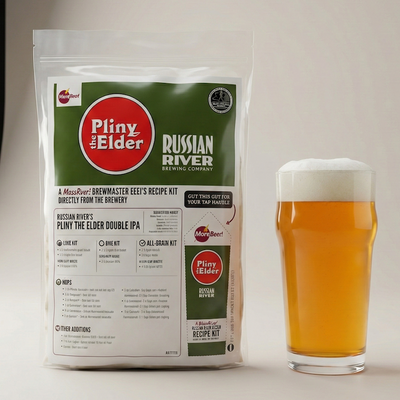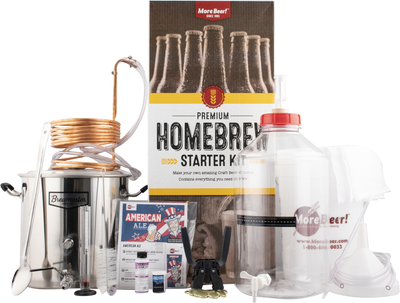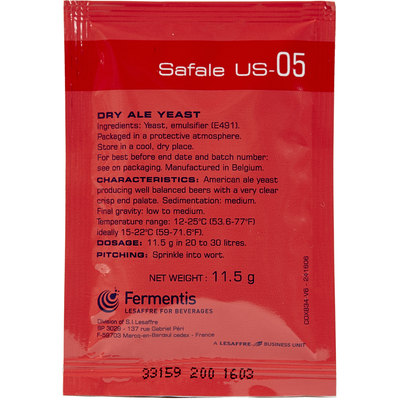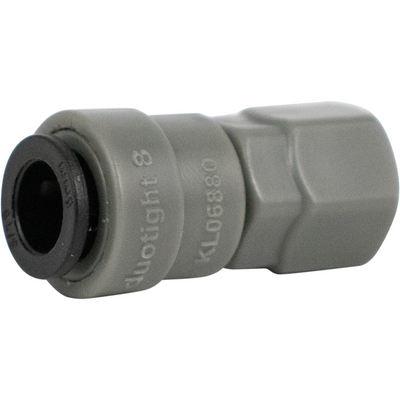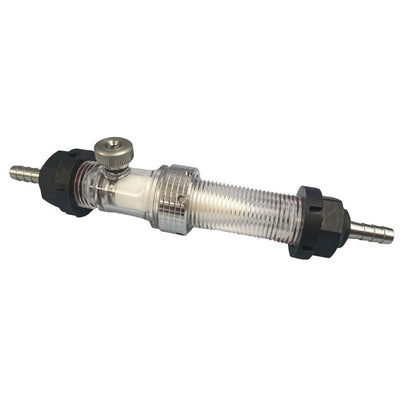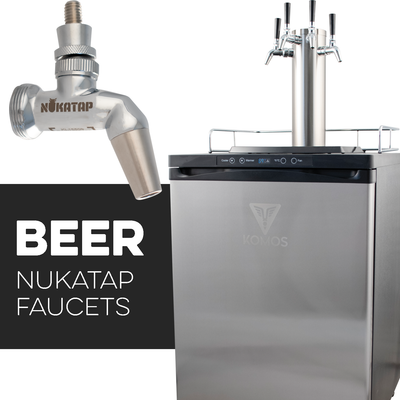Beer
BEER
-


Premium Home Brewing Kit
Everything that comes with our Deluxe kit plus some major upgrades Large 8.5-gallon brew kettle with ball valve port for easy transferring of liquids Copper wort chiller offers a quick & convenient way to chill wort — no ice bath required! Step-by-Step instruction pamphlet fine-tuned over 20 years for easy success Your choice of recipe kit included The Premium Homebrewing Starter Kit is our "get the best to start with" kit and comes with all the bells and whistles! Included in this beer brewing starter kit is a massive 8.5 gallon stainless steel brewing kettle, 7 gallon Fermonster fermenter, copper wort chiller, choice of ingredient kit, and all the time tested brewing equipment you need to make beer at home. Long story short, this kit has everything you need to start home brewing! We started with our Deluxe Homebrew Starter Kit (BRKIT200) and upgraded the brew kettle to an 8.5 gallon model. The larger volume kettle allows for Full-Boil brews which can have lighter color and better hop flavors. The included kettle spigot makes transferring liquid from your kettle to your Fermonster Fermenter safe and easy. Our kettle also includes a thermometer port with plug so that you can add a dedicated kettle thermometer at any time. You will also enjoy the new silicone handle grips and internally stamped volume markers. Then in order to quickly cool the beer after boiling we included our WC20 copper Wort Chiller (a $60 value!). To top it off, we upgraded the Fermonster by a gallon to a massive 7 gallon capacity. This can be key down the road when you want to brew certain styles of beer that foam a lot during fermentation. With smaller fermenters it can bubble right out of the top. Stay out of trouble by never making a mess! A larger kettle, wort chiller and bigger fermenter are some of the first upgrades new brewers make—save yourself the hassle and purchase these items at an amazing value as part of the Premium Homebrew Starter Kit, from Morebeer!™ The Fermonster Fermenter - A Huge Upgrade Over Standard Buckets or Glass "Carboy" Water Bottles Unlike buckets or glass carboys, the Fermonster fermenter was designed for brewing beer. It is made from tough, clear, virgin grade PET plastic so you can see the magic of fermentation. Unlike glass it will never break and shatter if dropped. It represents a huge upgrade over traditional buckets because these fermenters are much less likely to get scratched. Scratches can hold bacteria that can cause off flavors in the beer. The Fermonster comes with a built-in spigot that eliminates a long time issue in homebrewing of having to start a siphon to transfer your beer to the bottling bucket after fermentation is over. The large 4" lid allows for easily adding yeast, hops, or other additions. We also really love the molded-in level markers that tell you exactly when you have reached your desired volume. We Don't Skimp on Cleaning and Sanitizing Proper cleaning and sanitizing is one of the core tenants of making great beer. Some starter kits utilize an all-in-one cleaner/sanitizer that does neither job well. We’ve included the best-selling sanitizer for brewing, Star San. We also include Craftmeister oxygen-based cleaning tablets that make cleaning your Fermonster Fermenter a breeze. Other Upgrades That Make Brewing Easier We’ve also made a few items standard that really make the brew day easier including a thermometer for temperature monitoring and a hydrometer with testing jar for measuring sugar levels. Our reusable mesh bags allow for the easy removal of spent grain and hops at the end of the boil. The included stainless spoon is a really nice upgrade over plastic when you are stirring boiling liquids. Easy to follow, How-To Instructions with Videos & a FREE 800 Number with Actual Brewers to ask questions! We've taught hundreds of thousands of people how to brew in over 25 years. Our instructions are clear and simple to follow and will have you making great beer with batch number one. If you have any questions, call our on-staff brewmasters at 1-800-600-0033. In an age where 800-numbers and real customer service is going away, you can still call us and ask a question. Flip through our Interactive Brewing Instructions below and click on any play button to see a video of that step! Recipe Options: American Ale produces a light colored, hoppy Pale Ale that puts the beloved Cascade hop on full display. Cascade hops are one of the classic American hop varieties, and we love them for their citrus, grapefruit character. Pliny the Elder is a truly amazing beer with a cult like following. This beer is an intense Double IPA that is highly bitter with an intense hop flavor and aroma thanks to its 9 separate hop additions. Haze Craze is our most popular New England IPA recipe kit. This Hazy IPA is packed with all of the hop character you'd expect from a super juicy NEIPA, and is sure to please even the most discerning hop head. Wheat and oats lend a delightful mouthfeel and silky texture. Anchorage Amber is modeled after the very popular Alaskan Amber® Ale. For those who appreciate rich malt character much more than hop flavor, this beer is a must. This Kit Includes: 7 Gallon Fermonster fermenter with built in spigot, stopper, and airlock 8.5 Gallon Stainless Steel Brew Kettle w/ thermometer port, stainless ball valve, internal volume markers, Silicone handle grips Copper Wort Chiller for quick cooling Food Grade Bucket for bottling Mesh bags for grain and hops on brew day A Thermometer for easy temperature management Hydrometer for making key sugar measurements Transfer Tubing Bottling Wand with shut off valve Sturdy Bottle Capper Bottle Caps Bottle Cleaning Brush Star San Sanitizer for true sanitizing Large Stainless Steel Spoon for mixing Craftmeister Cleaning Tablets for super easy cleaning Your choice of recipe kit with yeast included You will also need one of the following to bottle or keg your beer: (48) 12 oz or (24) 22 oz cappable Beer Bottles or a Home Kegging System
$269.99
-


Deluxe Home Brewing Kit
Absolutely EVERYTHING you need to start brewing! The complete home brewery kit! Includes everything you need to brew 5 gallons of delicious beer at home! High quality 5-gallon stainless steel kettle perfect for brewing Fermonster brand brewing fermenter is clear so you see fermentation activity and eliminates the need to siphon with built-in spigot Step-by-Step instruction pamphlet fine-tuned over 20 years for easy success Your choice of recipe kit included Make brewing fun and easy with our new Deluxe Homebrewing Starter Kit only from MoreBeer!. This beer brewing starter kit includes the nearly indestructible Fermonster fermenter, a five gallon stainless steel brewing kettle, an ingredient kit of your choice and all the time-tested equipment you need to brew up 5 gallons / 2 cases of beer per batch. With the Deluxe Homebrew Starter Kit, you can choose from several recipes including the American Ale Hoppy Pale Ale, Irish Red Ale, I Heart IPA, and German Hefeweizen. The Fermonster Fermenter - A Huge Upgrade Over Standard Buckets or Glass "Carboy" Water Bottles Unlike buckets or glass carboys, the Fermonster fermenter was designed for brewing beer. It is made from tough, clear, virgin grade PET plastic so you can see the magic of fermentation. Unlike glass it will never break and shatter if dropped. It represents a huge upgrade over traditional buckets because these fermenters are much less likely to get scratched. Scratches can hold bacteria that can cause off flavors in the beer. The Fermonster comes with a built-in spigot that eliminates a long time issue in homebrewing of having to start a siphon to transfer your beer to the bottling bucket after fermentation is over. The large 4" lid allows for easily adding yeast, hops, or other additions. We also really love the molded-in level markers that tell you exactly when you have reached your desired volume. Five Gallon Stainless Kettle - It's Bigger Than What You Have in Your Kitchen Over the years we found that many brewers thought they had a big enough kettle. They would go home only to return and buy our five gallon stainless steel brewing kettle. To make brewing easy, we've discounted our five gallon brewing kettle to be able to include it from the start! Plus, because it is made of food-grade stainless steel, you don’t have to worry about any off flavors imparted by your boil kettle. We Don't Skimp on Cleaning and Sanitizing Proper cleaning and sanitizing is one of the core tenants of making great beer. Some starter kits utilize an all-in-one cleaner/sanitizer that does neither job well. We’ve included the best-selling sanitizer for brewing, Star San. We also include Craftmeister oxygen-based cleaning tablets that make cleaning your Fermonster Fermenter a breeze. Other Upgrades That Make Brewing Easier We’ve also made a few items standard that really make the brew day easier including a thermometer for temperature monitoring and a hydrometer with testing jar for measuring sugar levels. Our reusable mesh bags allow for the easy removal of spent grain and hops at the end of the boil. The included stainless spoon is a really nice upgrade over plastic when you are stirring boiling liquids. Easy, How-To Instructions & an Actual 800# We've taught hundreds of thousands of people how to brew in over 25 years. Our instructions are clear and simple to follow and will have you making great beer with batch number one. If you have any questions, call our on-staff brewmasters at 1-800-600-0033. In an age where 800-numbers and real customer service is going away, you can still call us and ask a question. Recipe Options: American Ale produces a light colored, hoppy Pale Ale that puts the beloved Cascade hop on full display. Cascade hops are one of the classic American hop varieties, and we love them for their citrus, grapefruit character. Irish Red Ale is a genre-defying brew that continues to be one of our best-selling kits year after year. You'll love the deep, red color and distinct caramel flavor. I Heart IPA was inspired by Bell's Two Hearted Ale, a universally adored IPA that features front-to-back hop additions of Centennial. Malt character takes a back seat to the pungent quality of citrus and lemon notes. German Hefeweizen has a lovely blond color and distinct hazy appearance in the glass. This kit uses 100% Bavarian Wheat malt extract with just a dash of Northern Brewer hops for bittering. This Kit Includes: 6 Gallon Fermonster fermenter with spigot, stopper and airlock 5 Gallon Stainless Steel Kettle Food-Grade Bottling Bucket with spigot Mesh Bags for steeping grain and hops on brew day Thermometer for easy temperature management Hydrometer for making key sugar readings Transfer Tubing Bottling Wand with shut off valve Sturdy Bottle Capper Bottle Caps Bottle Cleaning Brush Star San Sanitizer for true sanitization Large Stainless Steel Spoon for mixing Craftmeister Cleaning Tablets for easy cleaning Your choice of recipe kit with yeast included Everything You Need to Brew in One Box: This kit includes everything you need to start brewing amazing beer at home, all in one easy to wrap box. With our simple to follow step-by-step instructions and included choice of a delicious recipe kit, you will be brewing up your first batch of beer in no time at all. Don't settle for less when picking your homebrewing kit, pick MoreBeer! because we give you More! Fermonster Carboy - 6 gal. With Spigot: The Ported Fermonster is a brand-new fermenter designed specifically for fermentation. MoreBeer! gave product feedback for over 2 years of development and we think they nailed the design. The large lid allows for easy filling and makes hop or oak additions a breeze. The smooth sides are fantastic for sanitization - no ribs or texture to collect yeast or bacteria. The punted bottom allows sediment to collect to the sides so that you can siphon liquid from the center. Because they are made from virgin PET plastic, they're nearly unbreakable and a lot safer than similar glass carboys. Also notice the conical top which reduces surface area if you plan to store beer or wine long term. Five Gallon Stainless Steel Kettle: Made of high-quality stainless steel that is anything but cheap. The 0.5-mm thick sides and bottom are more than thick enough for this amount of liquid, and the riveted stainless steel handles on the kettle’s body make it easy to carry, even when filled. This 5-gallon kettle can safely hold up to 3 gallons of wort while boiling, making it the perfect size for brewing right in your own home! Great Customer Service Since 1995: As avid homebrewers ourselves, we strive to help new brewers make great beer right from the first batch. We have knowledgeable homebrewers ready to help you 6 days a week (Mon-Sat) on our Customer Service team. Got a question? We are glad to answer it. Have a problem? Let us help you. We’ve built our business on great customer service since we started in 1995. We also offer a vast library of Articles & Videos on numerous homebrewing topics. You will also need one of the following to bottle or keg your beer: (48) 12 oz or (24) 22 oz cappable Beer Bottles or a Home Kegging System
$159.99
-


Home Brewing Kit
Our most affordable brewing kit! Includes the most necessary items you'll need to make your first beer A great starter kit choice if you already have a 2.5-3 gallon pot at home Measuring & testing equipment included to track fermentation temperature and alcohol production Includes cleaning equipment and sanitizer so you'll be ready for your first brew and the next! Step-by-Step instruction pamphlet fine-tuned over 20 years for easy success Our Homebrewing Starter Kit gets you started in homebrewing at a very affordable price. It is also the simplest system to use. Anyone can follow the step-by-step directions and produce truly great beer with the first batch! This upgradeable system is designed around two, food-grade plastic buckets which feature our handy Sediment Block Spigots for quick and easy liquid transfers. After performing the Brew Day boil process, the first bucket is used to ferment the beer for two weeks. It's then transfered into the second bucket at bottling time, and out of that bucket into your bottles. This Kit Includes: Food Grade Plastic Six Gallon Ferrmenter with spigot, stopper and airlock Food Grade Bottling Bucket with spigot Mesh bags for steeping grain and hops on Brew Day Thermometer for easy termperature managment Hydrometer for making key sugar measurements Transfer Tubing Bottling Wand with shut off valve Sturdy Bottle Capper 50 Bottle Caps Bottle Cleaning Brush Star San Sanitizer for true sanitizing You Will Also Need: A Brewing Kettle A Beer Ingredient Kit for each batch you brew (48) 12 oz or (24) 22 oz cappable Beer Bottles or a Home Kegging System to package your beer
$84.99
-


Premium Home Brewing Kit With Kegging System
Due to high demand, this item is currently out of stock. Be the first to receive your items by placing a pre-order today. We will automatically ship this to you when we receive more inventory. Everything that comes with our Premium kit plus our Kegging Starter Kit Skip the bottling process and serve your very first home brewed beer on draft! Includes the best-selling 5-gallon Torpedo Keg — a huge upgrade over standard ball lock Cornelius kegs Brand new 5 lb CO2 cylinder can be filled at your local homebrew shop or welding supply store Step-by-Step instructions included for both brewing and kegging/carbonating your finished beer Why dip your toes in the water when you can take a running start and cannonball right into the world of homebrewing? With the Premium Homebrew and Kegging Starter Kit you can skip the bottling-induced headaches and go straight to kegging your first batch. Get everything included in two of our most popular kits at an even better value! Starting with the brewing equipment, you'll receive everything that comes with our top-shelf Premium Homebrew Starter kit (BRKIT300). This includes a massive 8.5 gallon stainless steel brewing kettle, 7 gallon Fermonster fermenter, copper wort chiller, American Pale Ale ingredient kit, and all the time tested brewing equipment you need to make beer at home. The large volume kettle allows for Full-Boil brews, which can have lighter color and better hop flavors. No need to fuss with a funnel or siphon thanks to the included kettle spigot, which can be used to safely and easily transfer liquid from your kettle to your Fermonster fermenter. The Fermonster is the perfect vessel for your first batch, and the 7 gallon capacity means you won't have to upgrade down the road when you want to brew beer styles that foam a lot during fermentation. Several of the most popular upgrades for new homebrewers include a larger kettle, a larger fermenter, and a wort chiller. With this kit you can check off those boxes on Day 1! Brewing is a labor of love. But few love the labor of bottling their finished brew. Luckily for you, everything from the 5 gallon Torpedo Homebrew Kegging kit (KEG410) is also included. When your brew buddies swap bottling horror stories, just listen and nod your head politely. We won't tell anyone that you skipped the bottling stage entirely! This system is comprised of absolutely everything you need to dispense your homebrew on draft. The dual gauge regulator will tell you the pressure in the keg, as well as how much CO2 is left in the tank. Comes with an aluminum CO2 tank that will never rust. 5 feet of 3/16" ID beer line, ideal for draft systems, so your beer drops to the correct pressure and does not excessively foam in the glass. Last but not least, this system features the 5 gallon Torpedo Keg, an all stainless ball lock keg with a commercial style. These kegs are stackable and feature rolled handles that make transport a breeze. The Fermonster Fermenter - A Huge Upgrade Over Standard Buckets or Glass "Carboy" Water Bottles Unlike buckets or glass carboys, the Fermonster fermenter was designed for brewing beer. It is made from tough, clear, virgin grade PET plastic so you can see the magic of fermentation. Unlike glass it will never break and shatter if dropped. It represents a huge upgrade over traditional buckets because these fermenters are much less likely to get scratched. Scratches can hold bacteria that can cause off flavors in the beer. The Fermonster comes with a built-in spigot that eliminates a long time issue in homebrewing of having to start a siphon to transfer your beer to the bottling bucket after fermentation is over. The large 4" lid allows for easily adding yeast, hops, or other additions. We also really love the molded-in level markers that tell you exactly when you have reached your desired volume. We Don't Skimp on Cleaning and Sanitizing Proper cleaning and sanitizing is one of the core tenants of making great beer. Some starter kits utilize an all-in-one cleaner/sanitizer that does neither job well. We’ve included the best-selling sanitizer for brewing, Star San. We also include Craftmeister oxygen-based cleaning tablets that make cleaning your Fermonster Fermenter a breeze. Other Upgrades That Make Brewing Easier We’ve also made a few items standard that really make the brew day easier including a thermometer for temperature monitoring and a hydrometer with testing jar for measuring sugar levels. Our reusable mesh bags allow for the easy removal of spent grain and hops at the end of the boil. The included stainless spoon is a really nice upgrade over plastic when you are stirring boiling liquids. Easy, How-To Instructions & an Actual 800# We've taught hundreds of thousands of people how to brew in over 25 years. Our instructions are clear and simple to follow and will have you making great beer with batch number one. If you have any questions, call our on-staff brewmasters at 1-800-600-0033. In an age where 800-numbers and real customer service is going away, you can still call us and ask a question. Brewing Equipment Included: 7 Gallon Fermonster fermenter with built in spigot, stopper, and airlock 8.5 Gallon Stainless Steel Brew Kettle w/ thermometer port, stainless ball valve, internal volume markers, Silicone handle grips Copper Wort Chiller for quick cooling Food Grade Bucket for bottling Mesh bags for grain and hops on brew day A Thermometer for easy temperature management Hydrometer for making key sugar measurements Transfer Tubing Bottling Wand with shut off valve Sturdy Bottle Capper Bottle Caps Bottle Cleaning Brush Star San Sanitizer for true sanitizing Large Stainless Steel Spoon for mixing Craftmeister Cleaning Tablets for super easy cleaning Delicious American Pale Ale recipe kit with yeast Kegging Equipment Included: Brand New 5 Gallon Torpedo Ball Lock HomeBrew Keg Beer line assembly with hand held faucet New Aluminum 5 lb CO2 tank Gas line assembly Premium Dual Gauge regulator The CO2 tank is shipped empty. You can have it filled at a welding supply shop or see your Yellow Pages under Gas- Industrial, Medical.
$509.99
-


Premium Home Brewing Kit With Stainless Fermenter
Everything that comes with our Deluxe kit plus some major upgrades Choose between standard Stainless Fermenter or with integrated heating element! Large 8.5-gallon brew kettle with ball valve port for easy transferring of liquids Copper wort chiller offers a quick & convenient way to chill wort — no ice bath required! Step-by-Step instruction pamphlet fine-tuned over 20 years for easy success Your choice of recipe kit included The Premium Homebrewing Starter Kit is our "get the best to start with" kit and comes with all the bells and whistles! Included in this beer brewing starter kit is a massive 8.5 gallon stainless steel brewing kettle, 9.25 gallon stainless steel fermenter (with or without heating element), copper wort chiller, Pale Ale ingredient kit, and all the time tested brewing equipment you need to make beer at home. Long story short, this kit has everything you need to start home brewing! We started with our Deluxe Homebrew Starter Kit (BRKIT200) and upgraded the brew kettle to an 8.5 gallon model. The larger volume kettle allows for Full-Boil brews which can have lighter color and better hop flavors. The included kettle spigot makes transferring liquid from your kettle to your Bucket Buddy Fermenter safe and easy. Our kettle also includes a thermometer port with plug so that you can add a dedicated kettle thermometer at any time. You will also enjoy the new silicone handle grips and internally stamped volume markers. Then in order to quickly cool the beer after boiling we included our WC20 copper Wort Chiller (a $60 value!). Either fermenter model you choose, it will come with an incredible 9.25 gallon capacity. This can be key down the road when you want to brew certain styles of beer that foam a lot during fermentation. With smaller fermenters it can bubble right out of the top. Stay out of trouble by never making a mess! A larger kettle, wort chiller and bigger fermenter are some of the first upgrades new brewers make—save yourself the hassle and purchase these items at an amazing value as part of the Premium Homebrew Starter Kit, from Morebeer!™ The Bucket Buddy Stainless Steel Fermenter With Optional Heating and Digital Control Stainless steel is a much better option than glass or plastic, as it is extremely easy to clean and virtually lasts forever! There's also much less chance of contamination as stainless doesn't scratch like plastic. Over time, you'll get scratches in plastic fermenters from normal wear and tear, creating microscopic havens for bacteria. Meanwhile, glass carboys are always at risk of breaking which is something you will never have to worry about with stainless steel. Another advantage over carboys and plastic buckets is the domed base inside this fermenter which is great for yeast flocculation when fermentation is complete. The included racking arm will make it easy to transfer out every last drop of beer while leaving the yeast cake undisturbed. The entire racking arm and ball valve assembly is weldless, which means you can remove the assembly to clean and sanitize it between batches. You can even boil the assembly for added assurance that it's been sterilized. Choose between the standard model or the upgraded model with built-in heating element and automatic temperature control! If you live in a cold climate, ale fermentations may be a seasonal affair, as cold ambient temperatures can easily drive down the temperature of your fermenting beer below your yeast's optimal fermentation temp range. The Bucket Buddy w/ Heating Upgrade offers a simple solution with an integrated heating element and digital temperature control. Program your fermentation temperature and if the temp drops below your set point the unit will gently heat your wort from the bottom up via the concealed element located in the base. For cooling, you can place the fermenter in a dedicated refrigerator or drill into the lid to install a Temp Twister Cooling Coil. A temperature controller probe can then be taped to the side of the fermenter to control your cooling source, or you can drill another spot in the lid for a thermowell. We Don't Skimp on Cleaning and Sanitizing Proper cleaning and sanitizing is one of the core tenants of making great beer. Some starter kits utilize an all-in-one cleaner/sanitizer that does neither job well. We’ve included the best-selling sanitizer for brewing, Star San. We also include Craftmeister oxygen-based cleaning tablets that make cleaning your Fermenter a breeze. Other Upgrades That Make Brewing Easier We’ve also made a few items standard that really make the brew day easier including a thermometer for temperature monitoring and a hydrometer with testing jar for measuring sugar levels. Our reusable mesh bags allow for the easy removal of spent grain and hops at the end of the boil. The included stainless spoon is a really nice upgrade over plastic when you are stirring boiling liquids. Easy, How-To Instructions & an Actual 800# We've taught hundreds of thousands of people how to brew in over 25 years. Our instructions are clear and simple to follow and will have you making great beer with batch number one. If you have any questions, call our on-staff brewmasters at 1-800-600-0033. In an age where 800-numbers and real customer service is going away, you can still call us and ask a question. Recipe Kit Included! American Ale produces a light colored, hoppy Pale Ale that puts the beloved Cascade hop on full display. Cascade hops are one of the classic American hop varieties, and we love them for their citrus, grapefruit character. This Kit Includes: 9.25 Gallon Stainless Fermenter with spigot, stopper, and airlock (with or without heating) 8.5 Gallon Stainless Steel Brew Kettle w/ thermometer port, stainless ball valve, internal volume markers, Silicone handle grips Copper Wort Chiller for quick cooling Food Grade Bucket for bottling Mesh bags for grain and hops on brew day A Thermometer for easy temperature management Hydrometer for making key sugar measurements Transfer Tubing Bottling Wand with shut off valve Sturdy Bottle Capper Bottle Caps Bottle Cleaning Brush Star San Sanitizer for true sanitizing Large Stainless Steel Spoon for mixing Craftmeister Cleaning Tablets for super easy cleaning Pale Ale recipe kit with yeast included You will also need one of the following to bottle or keg your beer: (48) 12 oz or (24) 22 oz cappable Beer Bottles or a Home Kegging System
$429.99 - $459.99

